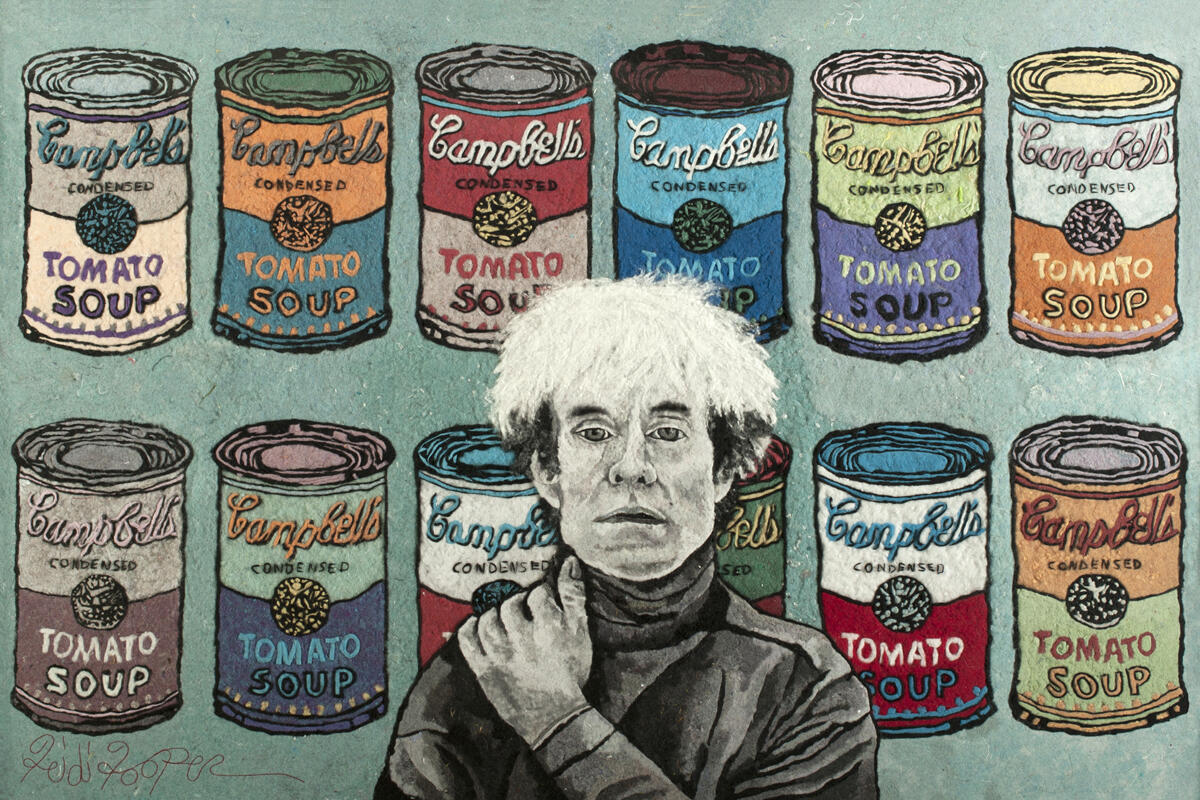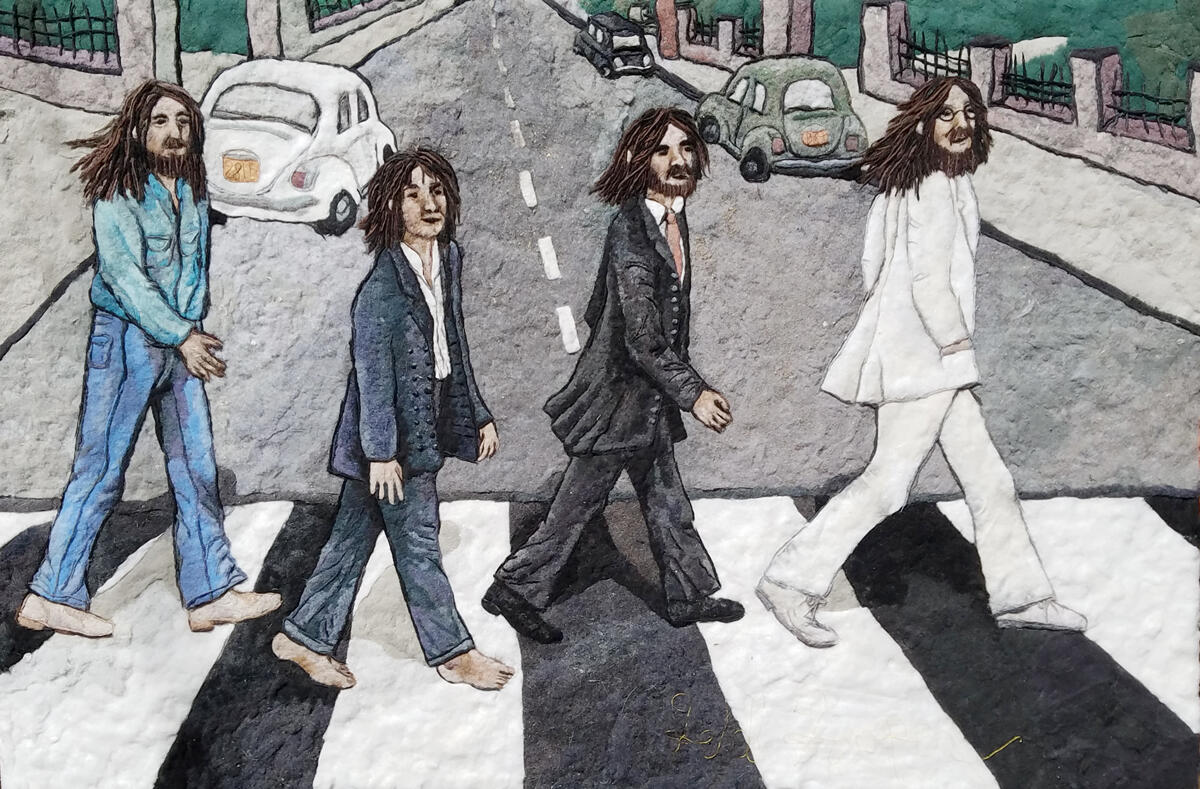
Jan. 22, 2019
How a VCU alumna used dryer lint to rescue her art career
Share this story
Heidi Hooper was a metalsmith working and teaching classes in the late 1990s in Boston before a cancerous tumor ate away the strength of her right arm and seemed to signal the end of her artistic career.
“I had been hammering eight to 10 hours a day,” said Hooper, whose artistic metal armor pieces had won costuming awards all over the world. “[The illness] was a huge jolt. It became so I struggled to hold a glass of water, let alone a hammer.”
Cancer treatments destroyed most of the muscles in her upper arm and left her with painful swelling. Hooper searched for a way she could still create, but even working with material such as soft clay was painful.
“In order to keep from getting too depressed, each day I gave myself something new to try, whether it was artistic or just cooking an egg,” Hooper said.
Inspiration struck in the odd form of guilt. Friends had given Hooper some soft chenille throws to comfort her through the cancer treatments, but a well-meaning helper accidentally destroyed them by putting them in the dryer.
“There was lint the size of two collie dogs,” Hooper said. “I felt really bad for the people who bought me these nice, beautiful, colorful chenille throws to cheer me up. I felt I had to do something with them.”

Trial and error
In the early 2000s, Hooper began the painstaking process of learning to make art from dryer lint, creating pieces at first that she describes as “horrible.” She and her husband had moved to the Pocono Mountains of Pennsylvania by then, and Hooper experimented in her home studio.
Hooper credits her time at the Virginia Commonwealth University School of the Arts with giving her the skills she needed to make her new medium work. “The sculpture department goes out of their way to try and have you learn every possible technique, even if you’re doing it for only one day, just to get the feel of different stuff,” she said. “That’s what I pulled on.”

Gradually, Hooper shaped the process she now uses. She draws a sketch of what she wants to create, takes a photo of the sketch for reference and covers it with archival tacky. She then layers colored lint on top of the glue until it’s a half-inch to an inch thick. She photographs the piece at that point so she can make prints. After that, she covers it permanently with glass for protection.
She began receiving beautifully colored lint from costumers and other fabric enthusiasts. Hooper’s artistic metal armor pieces had won costuming awards at WorldCon, an annual conference that offers some of the most prestigious awards in science fiction and fantasy circles. Many of the people she knew from science fiction conventions were excited about her new artistic direction. Hooper said those people get vivid colors out of their dryers, rather than the nondescript gray that’s produced by, say, an unsorted wash or clothes that have seen better days. Word spread through the convention circuit and as her art became known. Hooper said she now receives the equivalent of a small suitcase full of lint each month, which she keeps organized by tone and shade in a collection that has grown to nearly 800 repurposed plastic salad boxes.
“It was trial and error,” Hooper said. “It wasn’t a thrill or an excitement until it started working because I wasn’t where I wanted to be. I was determined to keep going and keep trying new things until I got something that worked.”

‘She’s got so much talent, it caught me off guard’
Hooper’s break came not long after she sorted out the process. Ripley’s Believe It or Not found examples of her work online and contacted her to purchase some. Her art now appears in Ripley’s museums around the world as well as in books the company produces.
Since then, she has made dryer lint art into a career. She sells commissioned pieces for about $350 each, offers prints as a reward to fans who donate small monthly sums to her through the website Patreon, and sells completed pieces through her website and in galleries for as much as several thousand dollars.

Hooper’s work is on exhibit at Gamut Art Gallery in Stroudsburg, Pennsylvania, in a show that opened Dec. 6 and continues through the beginning of March. Gallery curator Jim Evanisko said he was introduced to Hooper by another local artist. He was intrigued enough to visit Hooper’s home studio but was not prepared for what he saw.
“She’s got so much talent, it caught me off guard,” Evanisko said.
Evanisko had gone to see Hooper’s lint work, but as he walked through the house, he saw examples of her entire artistic career, including ceramics, silverwork and dolls and puppets, some from before her illness and some from the period in which she searched for a medium she could use to make art without too much pain.
“This was just too much to waste,” he said.
As a result, the show at Gamut Art Gallery includes art from various stages of Hooper’s life and work.
“My favorite thing about her is her sense of humor and the way she takes life,” Evanisko said. “With the hell she’s gone through, it just amazes me.”
He recalls a recent afternoon when Hooper came by the gallery to drop off a new work for sale in the show, “The Bride of Frankenstein’s Cat,” created from dryer lint.
“It was absolutely terrific,” Evanisko said.

The lint lady
Cats are a common theme in Hooper’s work. Pet portraits are a solid source of regular income as the fuzziness of dryer lint lends itself to portraying soft animals. Beyond that, she has envisioned superheroes, such as Wonder Woman, as cats and is working on a picture book that plays on words that include “cat,” such as “catfish” and “catatonia.”
Her five cats, McGonagall, Doctor Who, River Song, Mrs. Premise and Mrs. Conclusion have offered both succor and inspiration, she said.
“There’s so much cat stuff because whenever I have to lie down and rest, the cats just pile on me. They’re a super comfort and part of my daily routine,” Hooper said.
Hooper is not currently undergoing cancer treatments, but the swelling (stage 2 lymphedema) requires her to hook into a machine that massages her arm four times a day. The pain from that condition allows her only a few hours of working time a day, but she tries to make the most of them.
The quirkiness of her work has given her a reputation as “the lint lady,” but Hooper also has enjoyed prestigious recognition for her art. She won the Niche Award in 2014 for a large dryer lint piece featuring pop artist Andy Warhol, and again in 2017 for a piece honoring the surrealist artist Rene Magritte.
Hooper often says that, whatever comes, the “monster inside her” will continue to demand that she create, and she will find a way to do just that.
Subscribe to VCU News
Subscribe to VCU News at newsletter.vcu.edu and receive a selection of stories, videos, photos, news clips and event listings in your inbox.







